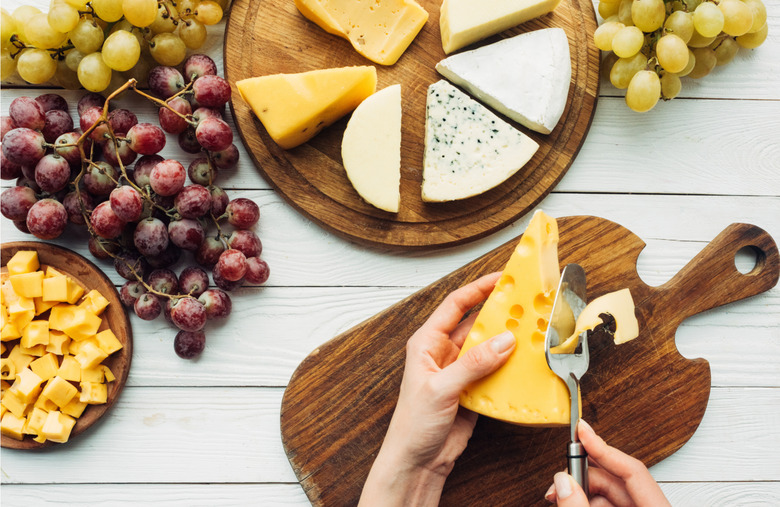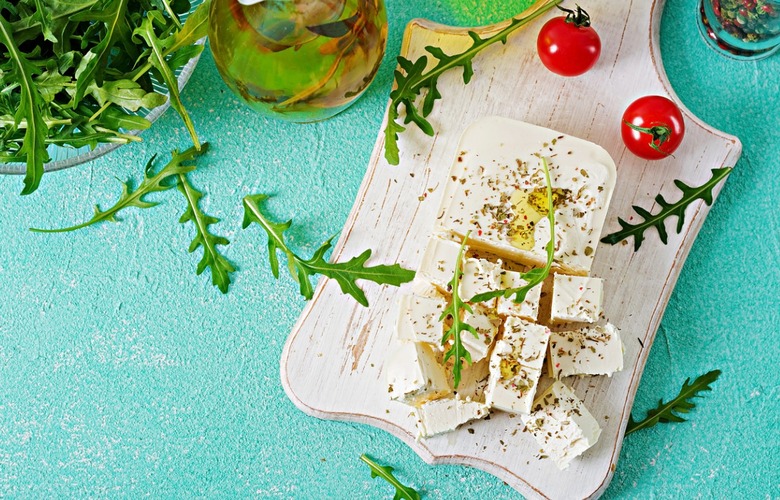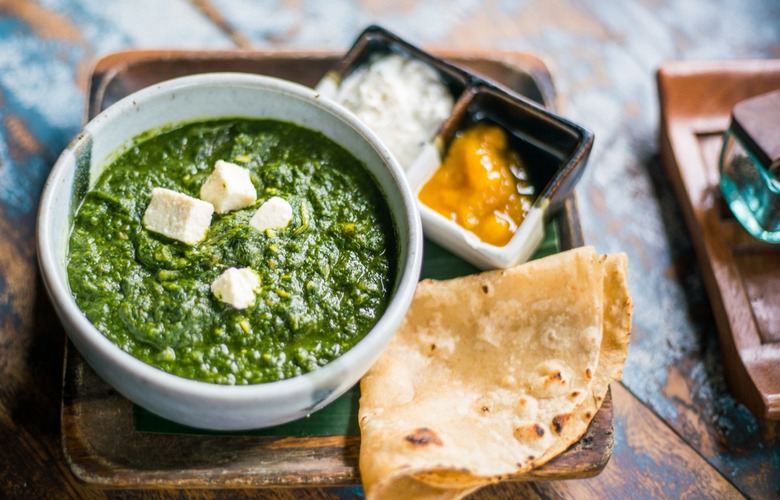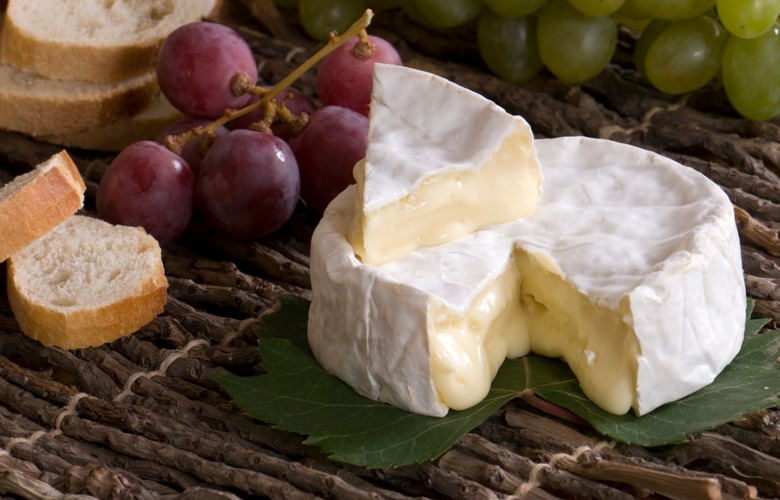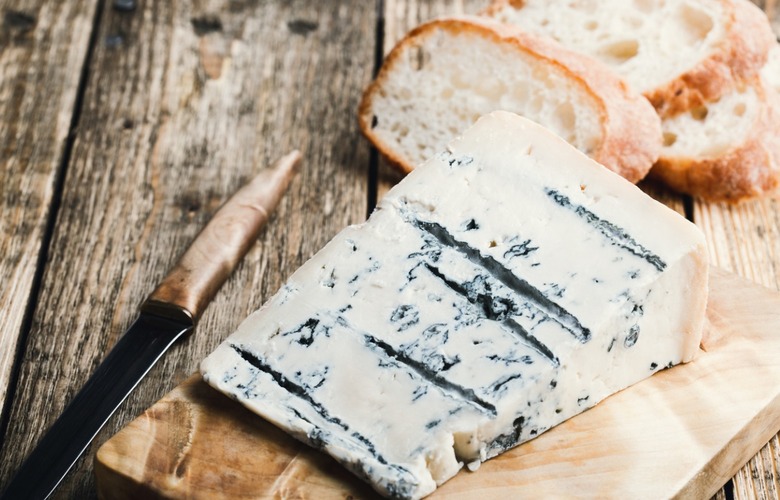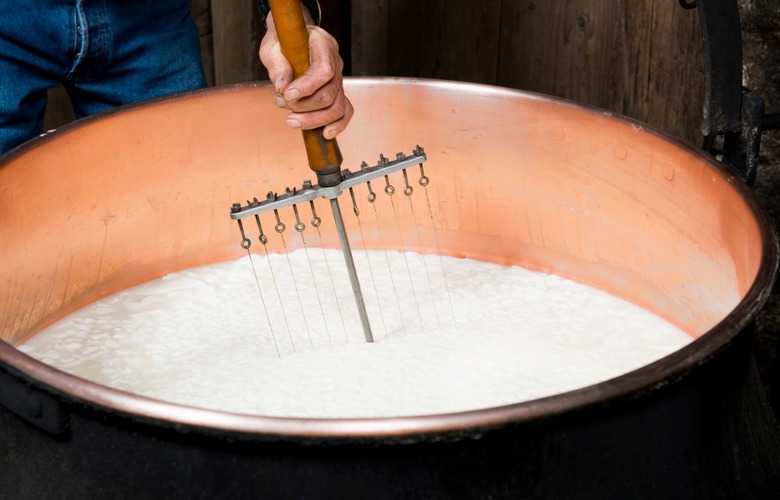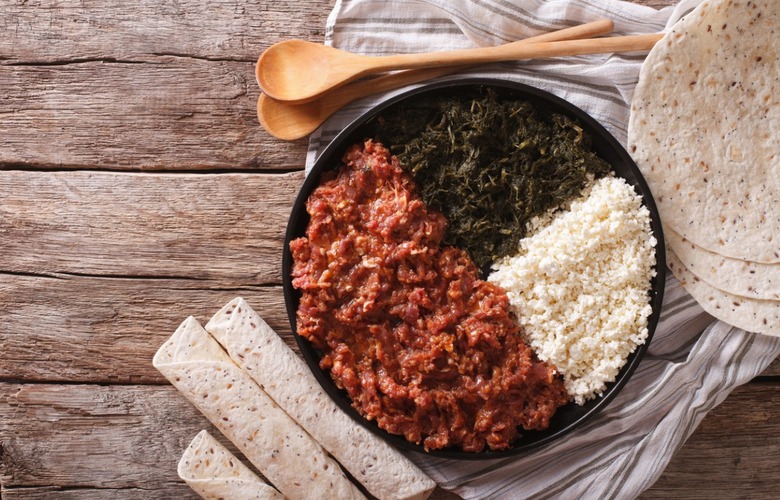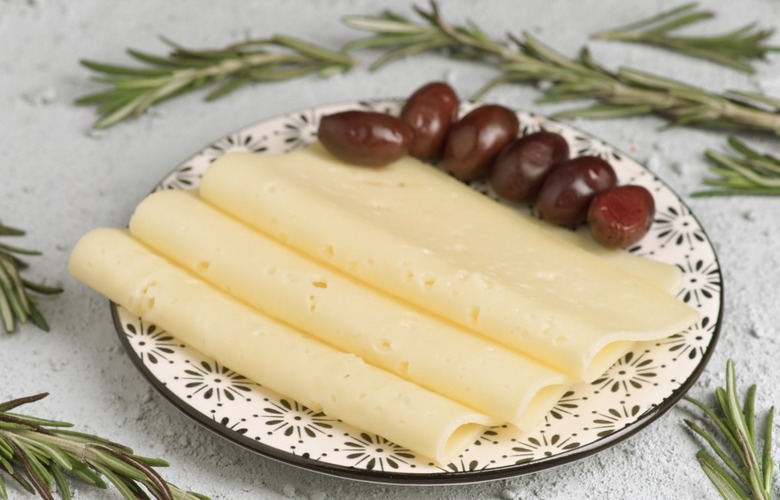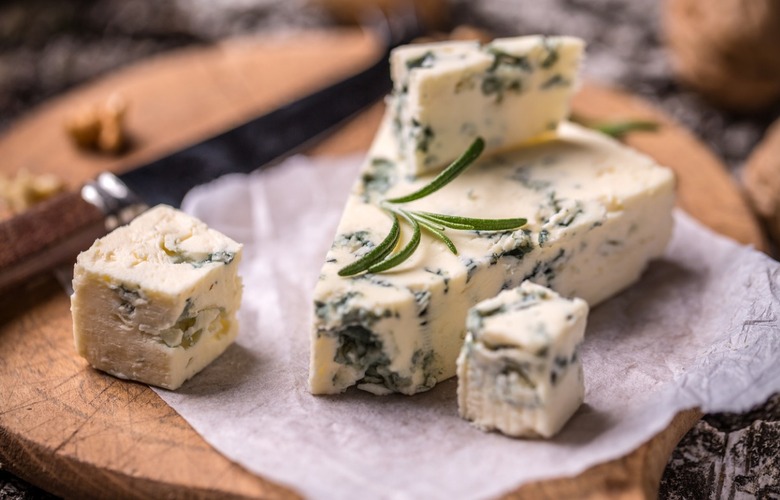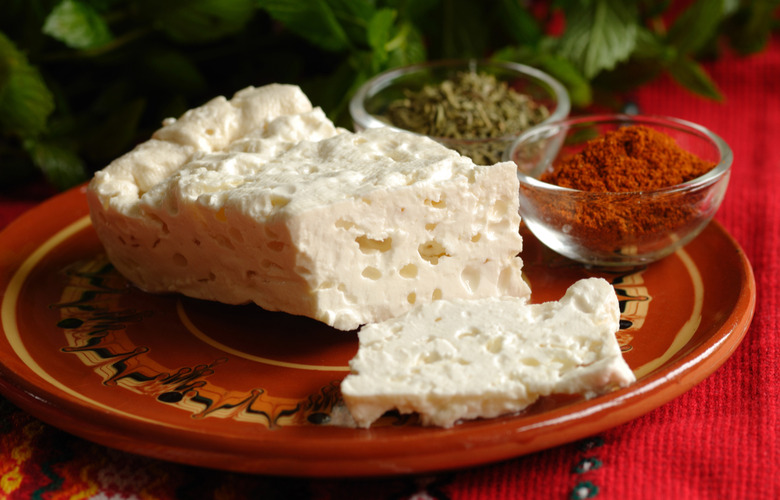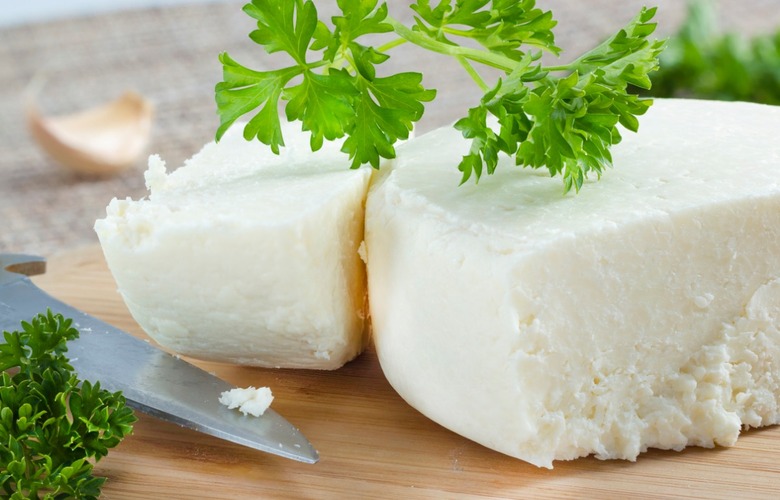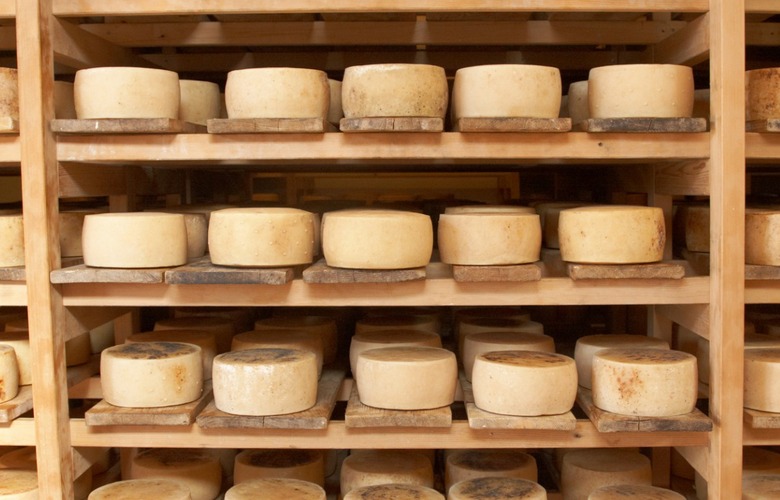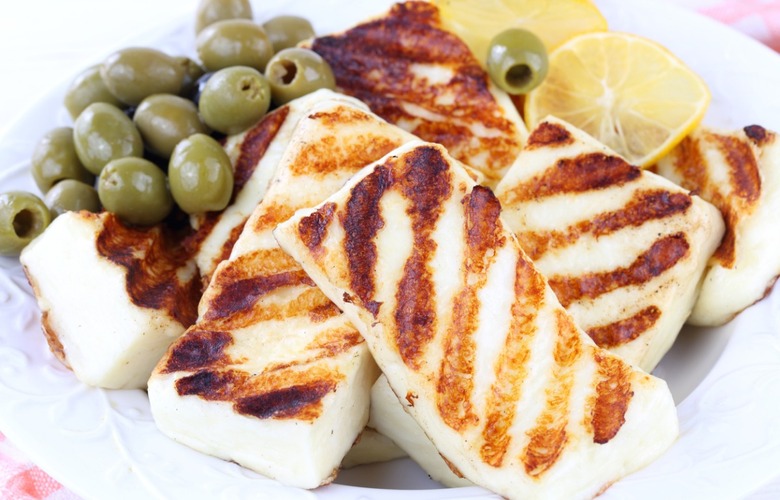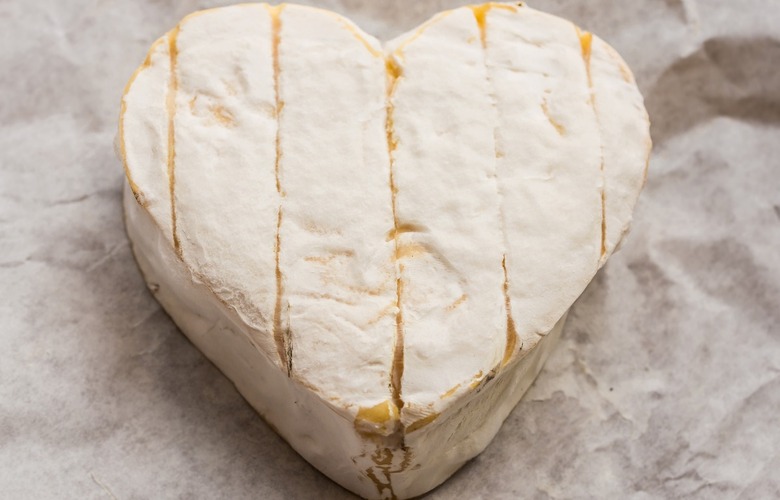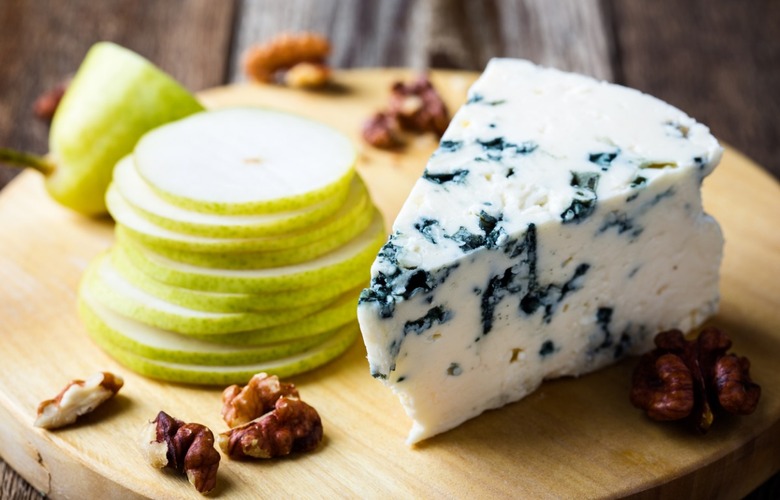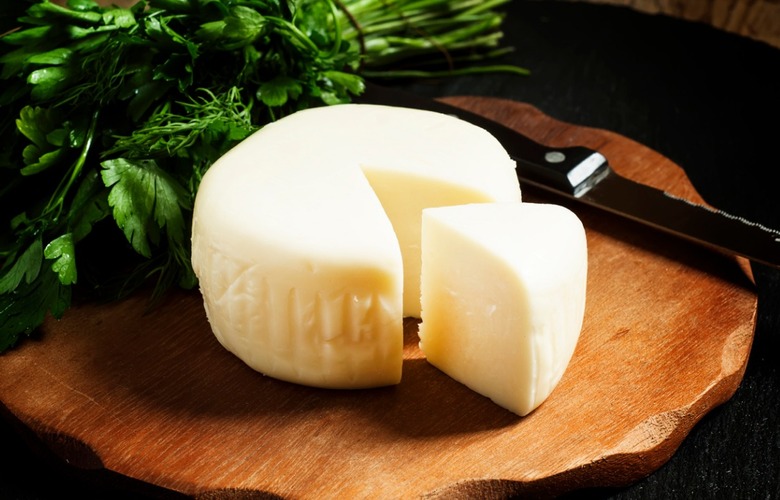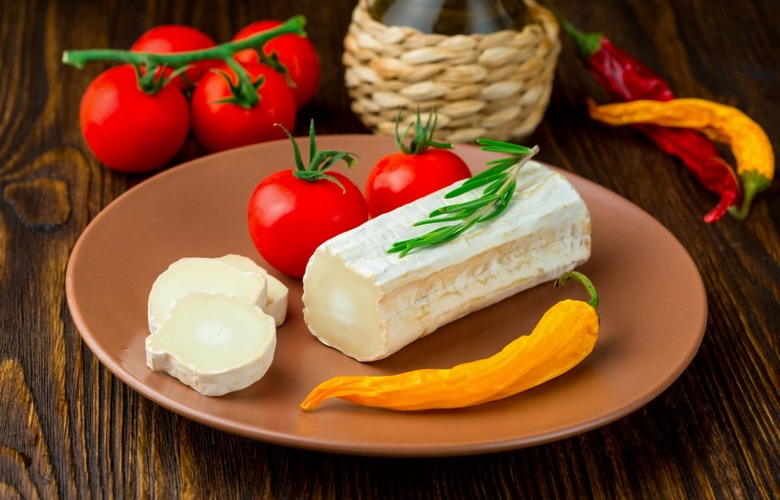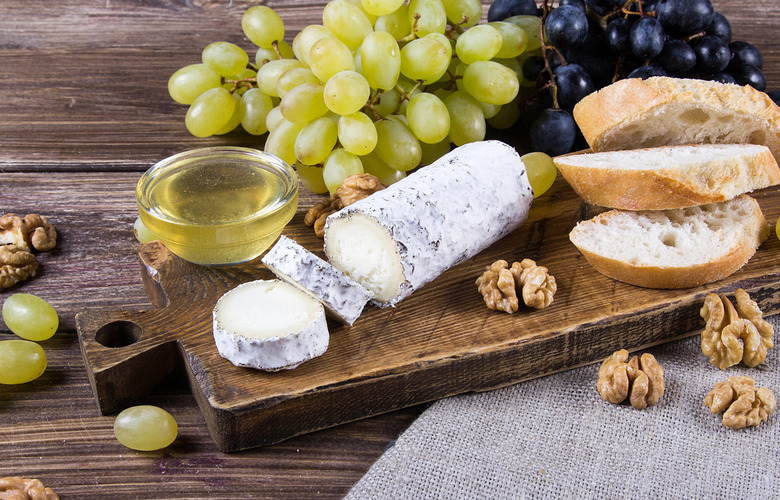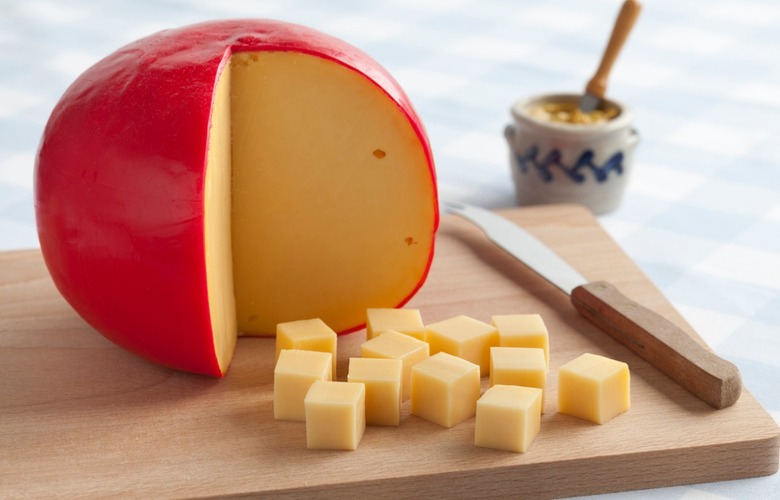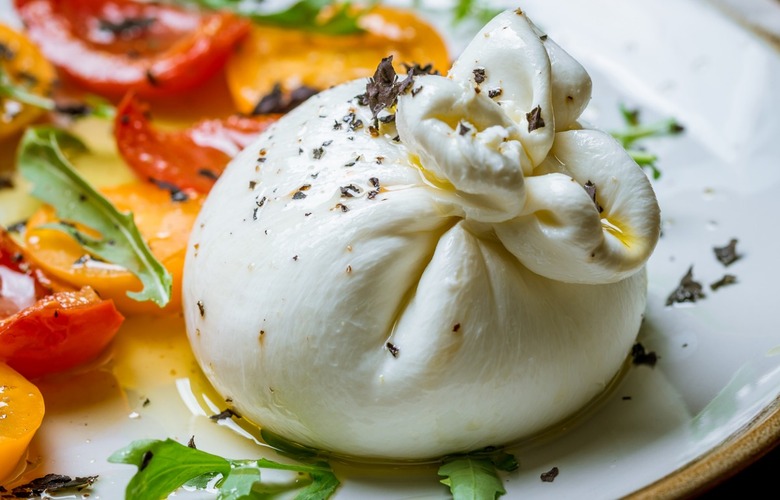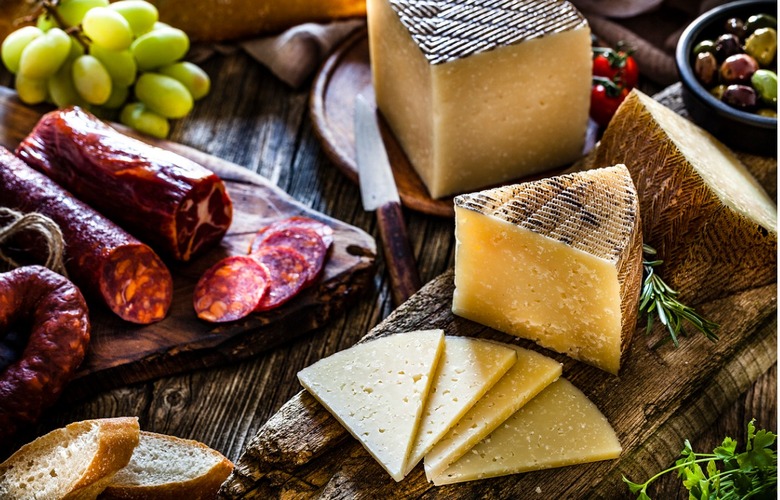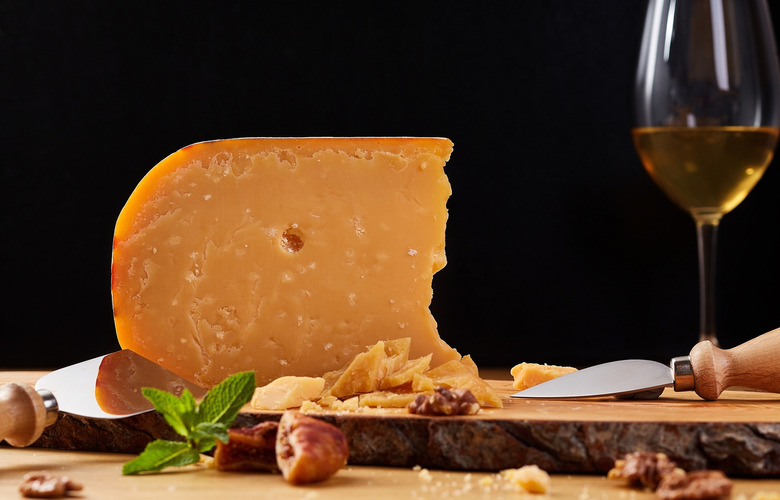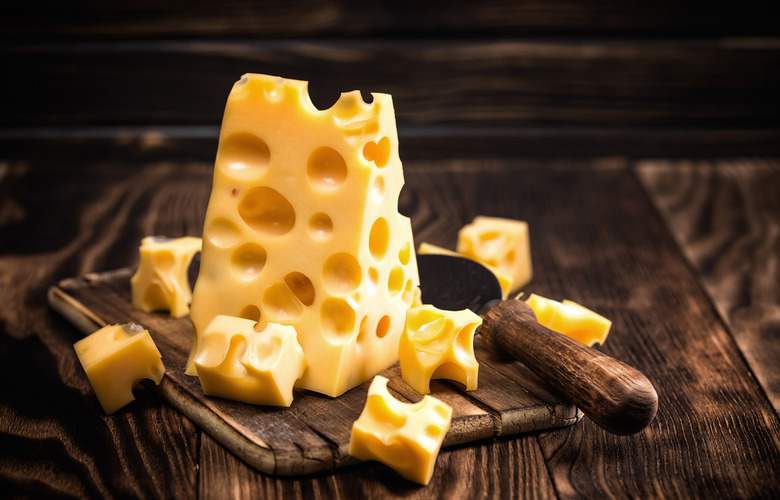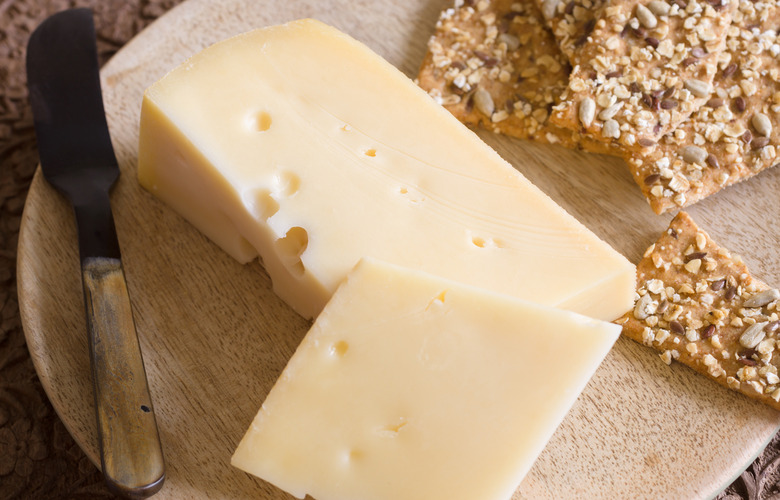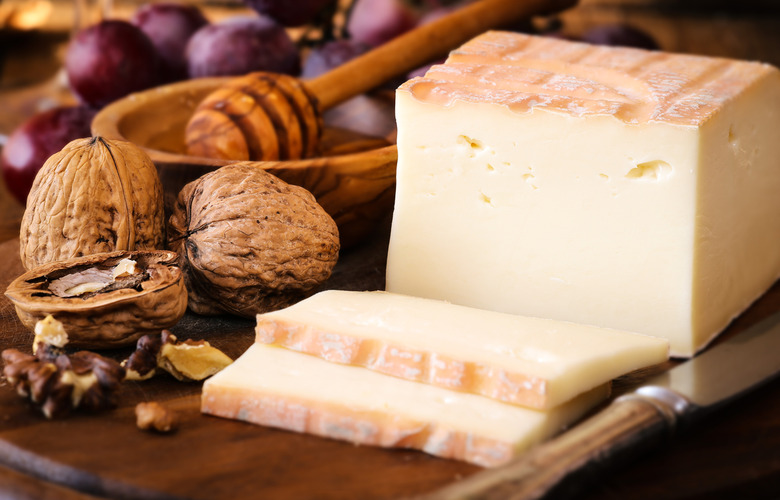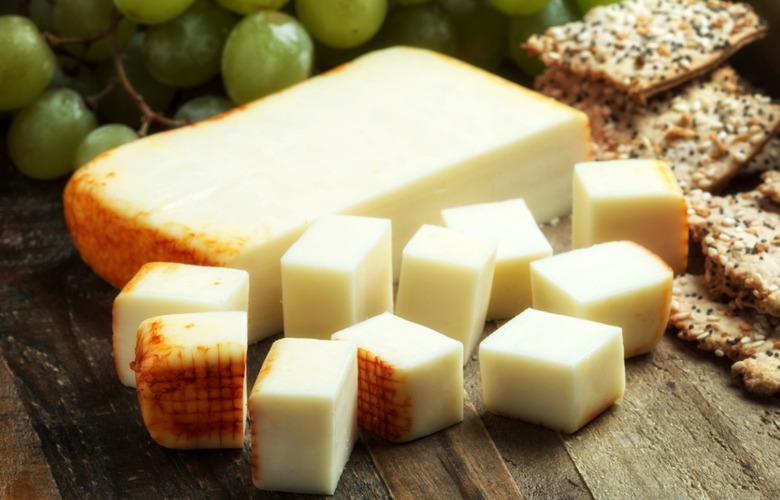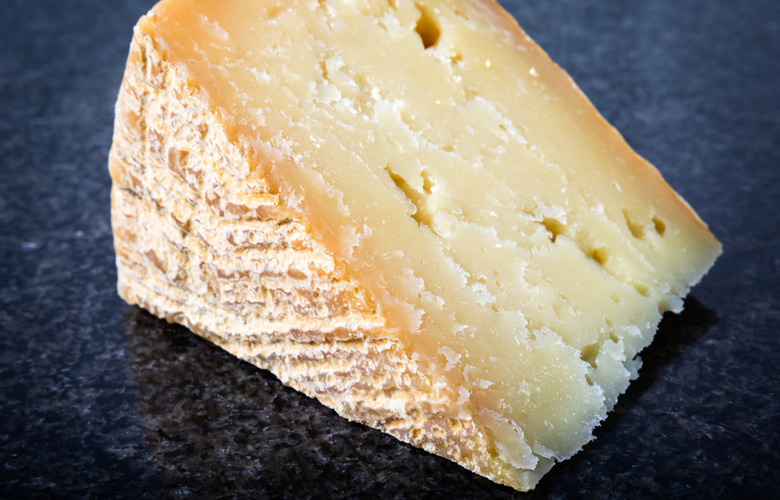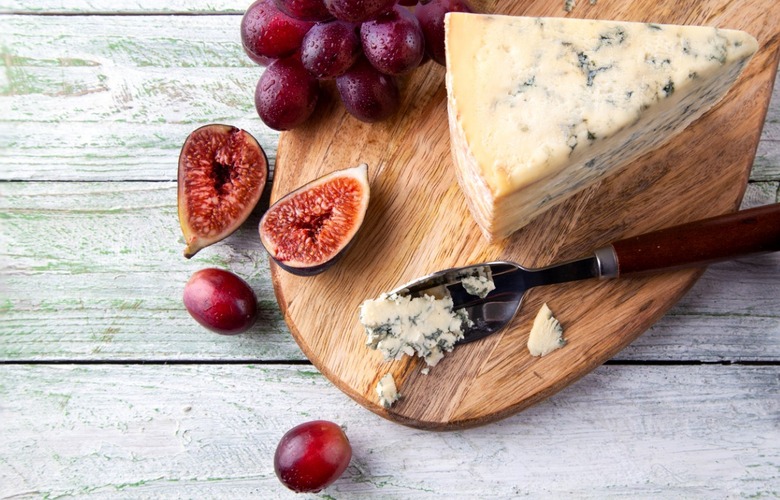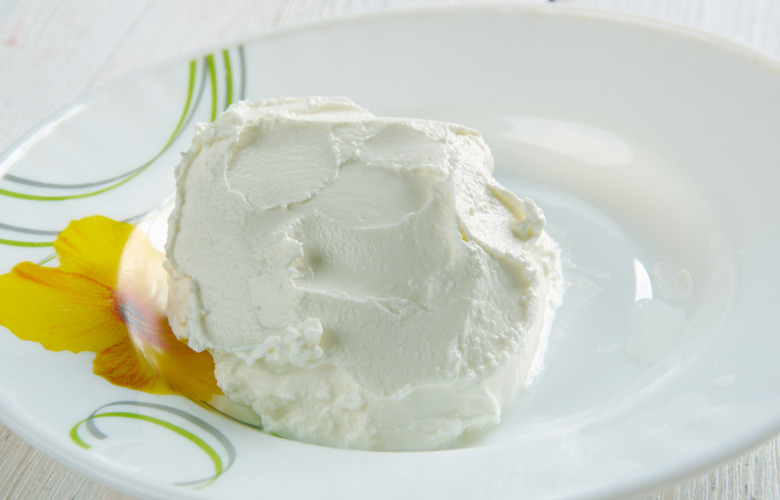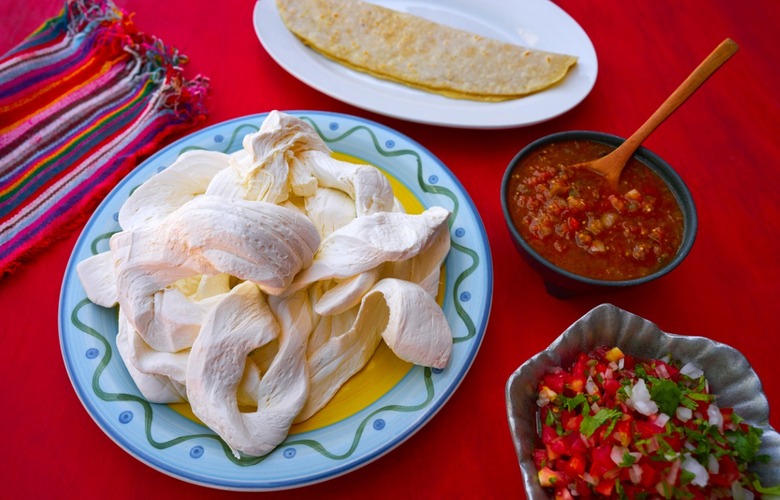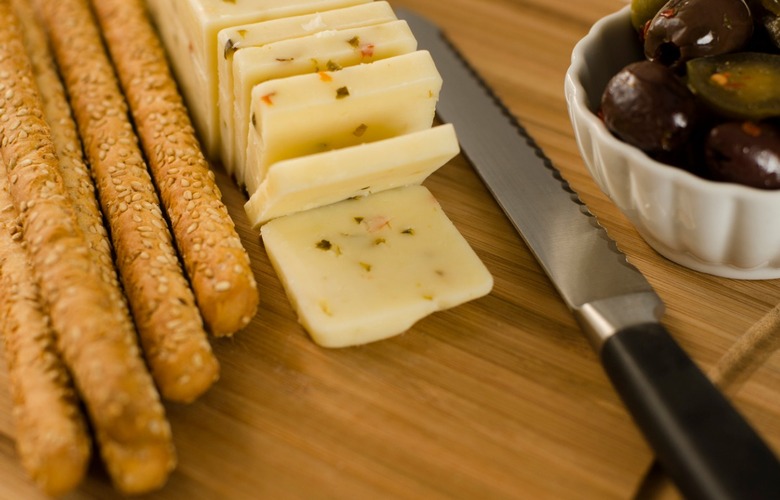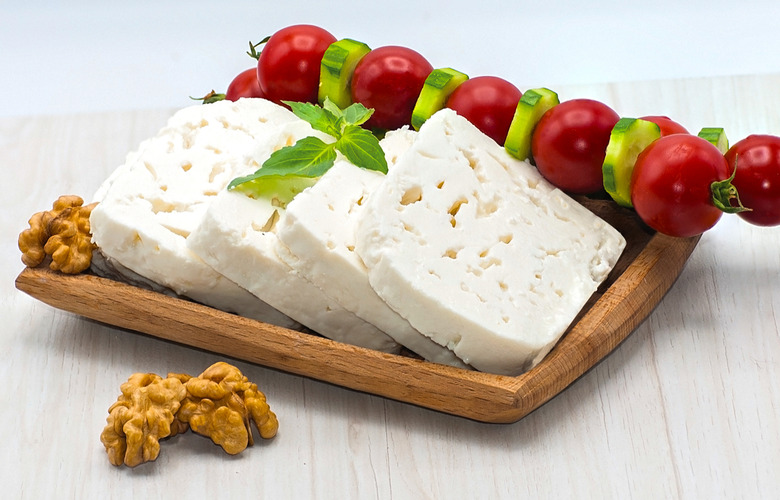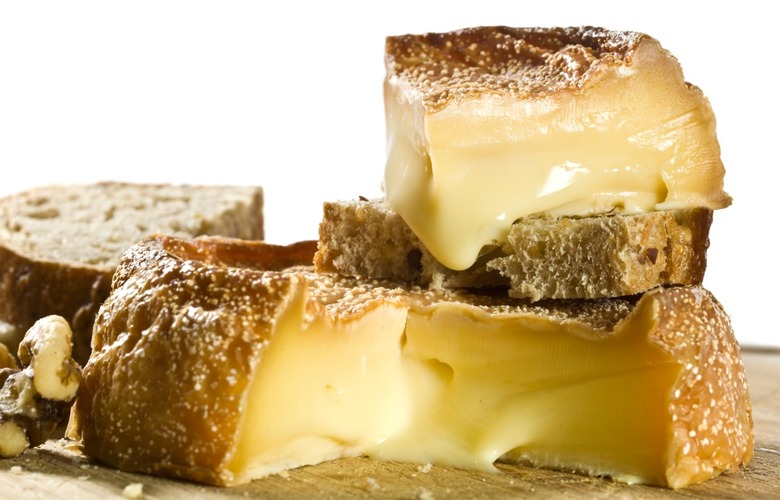Cheeses From Around The World Everyone Needs To Try
Going back to ancient times and throughout the world, cheese is a beloved comfort food and vital culinary ingredient. Researchers have found it to be a superfood, proving there are many reasons you should eat more cheese in your day-to-day life.
There are more than a thousand varieties of cheese from around the world for you to try, and while you may not be able to get to all of them, you can still get started. With so many differences in texture, processing, fat content, flavor, spices, smell and more, your perfect cheese is somewhere out there. As you travel the world and try out different cuisines, don't forget to check out these takes on cheese.
Feta (Greece)
A brined white cheese originating in Greece, feta is made from sheep's milk or a mixture of both sheep and goat's milk. With a tangy, salty flavor that ranges from mild to sharp, feta is an aged cheese with a crumbly texture and small to no holes, and it is popularly used in salads and pastries and as a table cheese.
Paneer (South Asia)
Cheese isn't a common part of South Asian cuisine, but paneer is one variety that has managed to have quite a presence, particularly in vegetarian dishes. This fresh, unaged cheese is made by adding food acid — such as that from yogurt, lemon juice or citric acid — to hot, curdled milk that is then strained. Paneer is a non-melting cheese, and is usually used in curries or desserts.
Camembert (France)
Camembert gets its name from the village where it originated in the northern French region of Normandy in the late 18th century. Moist and creamy, it's made from cow's milk that is traditionally unpasteurized and only surface-ripened. A wheel of Camembert cheese has an edible white rind with a soft, white interior that gets runny with maturation. Its mild and milky flavor has a bit of a buttery taste, and it is best eaten with bread, on a cheeseboard alongside grapes or baked whole.
Gorgonzola (Italy)
The town of Gorgonzola just outside of Milan claims to be the home of this veined blue Italian cheese, and indeed, it has produced its namesake cheese for centuries. Gorgonzola is still mainly produced in the northern regions of Lombardy and Piedmont using unskimmed cow's milk that is pasteurized. The cheese has a salty flavor, with the blue mold giving it more of a tang as well, and its texture is buttery or firm, as well as crumbly.
Berner Alpkäse (Switzerland)
There are very specific qualifications for a cheese to qualify as Berner alpkäse. The milk used to make the cheese must come from cows on specifically recognized farms in the Bernese Highlands, and the cows themselves must have only fed on pastures that have not been artificially fertilized, giving their milk a distinctive flavor thanks to the alpine herbs. Berner alpkäse is made on a wood fire using manual labor to produce a spicy, full-fat hard cheese that is usually eaten in slices.
Ayibe (Ethiopia)
Due to its mild flavor, ayibe is often served in Ethiopian cuisine as a complement to spicy dishes. It has a mild flavor and is similar to cottage cheese, but its crumbly texture is reminiscent of hard feta.
Havarti (Denmark)
Havarti is a semi-soft cheese made from cow's milk that has small holes distributed throughout and is typically used as a table cheese. Havarti's taste is affected by the fact that its curds are washed and that the interior is ripened. Smooth and rindless, its color ranges from cream to yellow, and it smells and tastes buttery, sweet and acidic. Traditionally, it is aged three months, but if aged even longer, havarti will taste saltier and a bit like hazelnuts.
Roquefort (France)
You may find similar cheeses in other places, but according to European Union law, only a sheep's milk cheese that has been aged in the Combalou caves of Roquefort-sur-Soulzon in Southern France may be labeled Roquefort cheese. One of the most famous blue cheeses and said to be a favorite of Charlemagne, Roquefort is white with characteristic veins of blue mold that give it a sharp, tangy taste. With no rind, it's also crumbly and a bit moist with a semi-hard texture.
Sirene (Balkans)
Made from cow, goat and sheep's milk, sirene is a brined cheese originating in southeastern Europe. Particularly popular in Albania, Bosnia, Bulgaria, Croatia, Macedonia, Montenegro, Romania and Serbia, it's a white cheese that's slightly crumbly and grainy and used as a table cheese, as well as for baking and in salads.
Cotija (Mexico)
A handmade Mexican hard cheese made from cow's milk, cotija is named after the mountain town of Cotija in the southwestern state of Michoacán. It comes in two forms: cotija de montaña, which is dry and firm with a very mild, salty taste, and tajo, which is more moist, less salty and fattier, tasting similar to feta. Its crumbled or grated form is popular in soups, salads, tacos and burritos.
Paški sir (Croatia)
Also known as Pag cheese or Pag Island cheese, paški sir is a hard sheep's milk cheese that comes from the Croatian island of Pag. The island's salt dust and aromatic plants are consumed by a native breed of sheep, the taste of which are found in the sheep's milk and therefore the paški sir.
Halloumi (Cyprus)
A Cypriot cheese popular throughout the Levant, as well as Egypt and Turkey, halloumi is an unripened cheese with a high melting point that is often fried or grilled. To make halloumi, rennet is used to curdle unpasteurized milk that usually comes from both goats and sheep, although it sometimes also has cow's milk. The result is a semi-hard, white cheese with a layered texture and salty taste. Mint is said to keep halloumi fresh, so you'll often find mint leaves garnishing the cheese or even contained in packages of it. It is frequently served with vegetables or in salads, with many regions using it as a breakfast food, snack or side dish. In Cyprus itself, halloumi is often eaten with watermelon or alongside smoked pork or lamb sausages.
Neufchâtel (France)
Another Normandy cheese, Neufchâtel is one of France's oldest cheeses, believed to date back to the sixth century and made in the commune of Neufchâtel-en-Bray. Soft and slightly crumbly, it's matured for eight to 10 weeks and characterized by a salty, mushroom-like taste and smell, as well as a grainy texture. Neufchâtel has a dry, white edible rind and is usually sold in a heart shape.
Danablu (Denmark)
A mixture of full fat cow's milk and homogenized cream is aged for eight to 12 weeks in order to make Danablu, a semi-soft, blue-veined cheese that was invented in the early 20th century in imitation of Roquefort. With a white or yellowish color and edible rind, Danablu's flavor is milder than Roquefort, although still moist, sharp and salty. It is commonly served on bread or crackers, in salads or with fruit.
Leipäjuusto (Finland)
Known as Finnish squeaky cheese in the U.S. on account of the sound it makes when one bites into it, leipäjuusto is made from cow beestings, or the first milk drawn from a cow after it has given birth, although the milk can also come from reindeer or goat. Leipäjuusto typically comes in a 2- to 3-centimeter-thick disk that is traditionally grilled, flambéed or baked, and its name means "bread cheese" on account of its appearance. Traditionally, leipäjuusto is served in slices alongside (or in) coffee, but it's also eaten with cloudberries (either fresh or in jelly) or in a salad.
Sulguni (Georgia)
Originating in the Samegrelo region of western Georgia, sulguni is a sour and somewhat salty cheese made from homogenized cow or buffalo milk, or a mix of the two. Ranging from white to pale yellow in color and typically served in wedges, it has an elastic consistency and dimples in its surface. It is traditionally deep fried before eating, which serves to mask its smell.
Graviera (Greece)
The second most popular cheese in Greece after feta, graviera is typically made from sheep's milk that has been ripened for at least five months, resulting in a burnt caramel flavor, although it's also made with cow milk in certain parts of the country. You can buy it in wheels, and its hard rind will typically have a crisscross pattern thanks to the draining cloth used on it. Used in salads and casseroles or eaten as a fried snack or pasta topping, graviera has a hard, oily texture.
Sainte-Maurie de Touraine (France)
Made with full-fat goat's milk, Sainte-Maurie de Touraine is an unpasteurized cheese named for a small town in west-central France. The soft, white cheese is formed into a small log and rolled in wood ash, giving a grey tinge to the moldy rind.
Edammer (Netherlands)
Edammer, also known as Edam, is a semi-hard cheese with a yellow interior and red paraffin wax rind that is sold in rounded cylinders and only hardens rather than spoils. Younger Edam cheese has a mild taste that's either a bit salty or nutty with very little smell, and is typically eaten with fruits such as apricots, cherries, melons and peaches. As it ages, the taste of Edam becomes sharper and its texture gets firmer, making it perfect to eat with apples and pears. Crackers and bread are also common accompaniments, and it pairs well with sparkling wine, chardonnay, pinot gris, shiraz, and both dry and semidry riesling.
Burrata (Italy)
Burrata is a fresh cheese, best eaten at room temperature within 24 hours of opening its container. It is made out of out of mozzarella and cream made from cows' milk (or sometimes buffalo milk), giving it a rich and buttery flavor. Produced in the Apulia region of southern Italy, burrata has a softer texture on the inside than on its mozzarella exterior, and it's popularly eaten with fresh tomatoes and olive oil or with salad, bread, prosciutto crudo or pasta.
Manchego (Spain)
A product of the La Mancha region of central Spain, manchego comes from Manchega sheep's milk which is aged between 30 days to two years. Firm and compact, but with a buttery texture, manchego ranges from white to a light yellow in color. Its rind, which ranges in color from yellow to beige, gives it a distinctive look due to its zig-zag pattern that is left by the mold the curds are pressed into when making the cheese. Its strong, tangy taste has a nutty and caramel-like flavor, with an aftertaste like that of most other sheep's milk cheeses.
Gruyère (Switzerland)
Named for the Swiss town of Gruyères, Gruyère is a hard, nonpasteurized yellow cheese produced in western Switzerland. A sweet and slightly salty cheese, the taste of Gruyère depends on its age; when young, it has a creamy and nutty flavor, whereas older cheeses have a stronger, earthier taste. It is fully aged at five months to a year, when small cracks appear in the cheese, giving it a bit of a grainy texture. Because of the fact that its unique flavor is still not overpowering, Gruyère is popular in baking, and it's also a great cheese for fondues. A great table cheese that's often grated for salads and pastas, Gruyère is also popularly used for croque-monsieur (a French toasted ham and cheese sandwich) and to top French onion soup.
Emmental (Switzerland)
In North America, "Swiss cheese" is usually used as a generic term for several, mostly North American cheeses that only resemble the real thing: Emmental. A typical product of the valley of the Emme River in west-central Switzerland, this savory yet mild cheese dates back to ancient times and remains popular among cheese-lovers today. Yellow in color and medium-hard in firmness, its characteristic holes and fruity flavor have lent to its popularity in sandwiches, gratin and fondue, in which it is typically mixed with Gruyère.
Jarlsberg (Norway)
An all-purpose cheese that can be eaten as a snack or used in cooking, Jarlsberg originates in the town in southern Norway from which it gets its name. A semi-soft yellow cheese with large holes, it has a mild, buttery and nutty flavor and should be aged at least three months if not longer.
Taleggio (Italy)
Taleggio has been around since Roman times, as evidenced by its mention in the writings by Cato the Elder, Pliny the Elder and Cicero. Originating in northern Italy, the semi-soft, smear-ripened cheese gets its name from Val Taleggio, an Alpine region in the Lombardy province. While its smell is quite strong, Taleggio's fruity flavor is relatively mild. Made in the autumn and winter, the cheese is produced with pasteurized or raw cow's milk and set on wood shelves in chambers, or even caves in more traditional processes, where it matures after six to 10 weeks. During that time, a seawater sponge is used to wash the cheese once a week in order to prevent mold from growing, which also results in its characteristic thick orange or rose-colored crust.
Muenster (United States)
Believed to be inspired by the Alsatian Munster-géromé cheese brought to America by German immigrants, Muenster is a semi-soft cow's milk cheese with an orange rind and smooth, pale interior. The color of the rind comes from annatto, a seasoning that's sweet, nutty and peppery in flavor, while the cheese itself is mild in flavor, although it can get stronger with age. Muenster melts very well, making it perfect for grilled cheese, melts, macaroni and cheese, burgers, quesadillas and pizza.
Pecorino Romano (Italy)
A hard, sharp and salty cheese that comes from sheep's milk, 97 percent of pecorino Romano cheese is made on the Italian island of Sardinia. One of Italy's oldest cheeses, it was a food staple for ancient Roman legionaries and is today most commonly used in its grated form, particularly on pastas. In order for a cheese to be considered pecorino Romano, it must be produced using lamb rennet paste that has been made with the milk of sheep raised in a specific area, dry salted by hand, and aged between eight and 12 months.
Stilton blue (England)
One of the most famous blue cheeses comes from central England, where production in the counties of Derbyshire, Leicestershire or Nottinghamshire is required in order for it to be labeled Stilton. Other requirements for Stilton blue cheese are that it must be cylindrical in shape, be unpressed, form its own crust, and have thin blue veins radiating from the center, as well as the cheese's characteristic sweet and salty flavor.
Nabulsi (Palestine)
Named for the Palestinian village of Nablus from which it comes, Nabulsi is a popular cheese in the West Bank and its surrounding area, as well as in Jordan. Sheep's milk is typically used to produce Nabulsi cheese, as well as sometimes goat's milk, and it is also flavored with mastic and a Middle Eastern spice called mahleb. A semi-hard brined cheese, Nabulsi is white and rectangular, often used as a table cheese, eaten as a snack fried in oil, or used to make knafeh, a traditional Palestinian dessert.
Quesillo de Oaxaca (Mexico)
Dominican friars brought pasta filata — the string cheese process used to produce mozzarella — from Italy to Mexico, where they used cow's milk to make the white, semi-hard cheese known as quesillo de Oaxaca, after the southern Mexican state where it was first made. Commonly referred to as quesillo, it's a common ingredient in quesadillas and empanadas.
Monterey Jack (United States)
Monterey Jack is a mild, white American cheese with a slightly sweet taste and a semi-hard texture. Its name comes from the fact that it was first made by Franciscan friars in Monterey (now in California) in the 18th century and then later sold commercially by a businessman named David Jack. The Monterey Jack you find in stores is usually aged about a month, but a harder variety called dry jack is aged for up to six months. Another very popular variety of Monterey Jack is pepper jack, which is flavored with bell peppers, chile peppers and herbs.
Lighvan (Iran)
Typically eaten for breakfast or with fresh bread at dinner, lighvan is an Iranian brined curd cheese made from sheep's milk. Produced in triangular blocks, the white cheese is characterized by holes and a sour flavor.
Époisses (France)
Officially named Époisses de Bourgogne, this soft-paste, red-orange cheese is made in the village of Époisses and the surrounding area, the département of Côte-d'Or, part of the former duchy of Burgundy. Made from raw or pasteurized cow's milk, the cheese is smear-ripened and washed in brine and brandy. Sold in wheels either 10 or 18 centimeters in diameter, the cheese has an extremely pungent smell and spicy taste, often served with a spoon and paired with Trappist beer or Sauternes wine. You'll have to travel to France to try the original unpasteurized version, however, as its one of the many cheeses banned in the United States.
More from The Daily Meal:
The 34 Gooiest, Creamiest, Most Over-the-Top Macaroni and Cheese Recipes
From Chai to Rooibos: Tea Around the World
